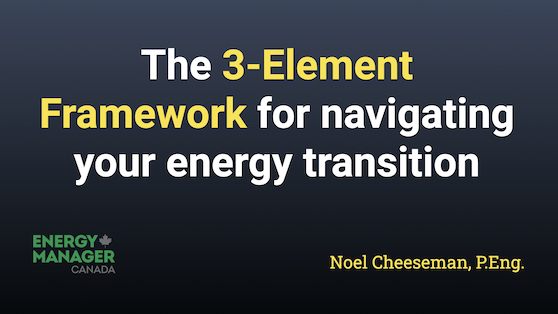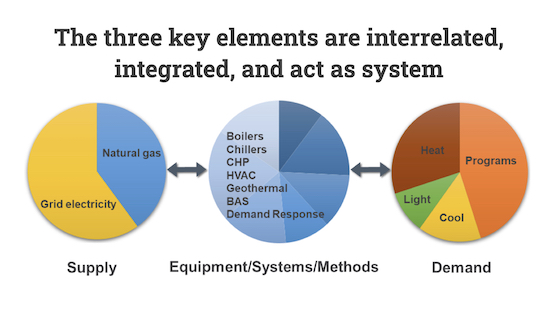
Features
The 3-Element framework for navigating your energy transition
August 24, 2021 By Noel Cheeseman, P.Eng.

August 24, 2021 – By 2023, it is likely that many natural gas consumers in Ontario will pay more in carbon charges than they pay for natural gas itself.
Consider: the Supreme Court of Canada’s ruling on the constitutionality of federal carbon legislation along with Ottawa’s establishment of a carbon price schedule to 2030 have firmed up the carbon price signal. The result is an intensification of planning on the part of many energy users to decarbonize their energy supply to mitigate these increased costs.
Planning for the energy transition
How should one plan for such large, potentially costly, unprecedented changes? As D-Day commander General Eisenhower said:
“Plans are useless, but planning is indispensable”.
The value of planning is that it forces the planner to look at many interrelated parts, and the dependencies and contingencies that must be considered for success. It is unlikely such a plan will be implemented as-is, as first conceived. However, the process of planning helps the organization anticipate possible challenges or obstacles that will arise and understand their impact, giving them the confidence to pivot toward new, viable solutions.
Many organizations embarking on the energy transition path tend to look at specific items, like a gas-fired boiler, and say “Let’s replace it with an electric one”, or “Let’s add solar PV to our mix and become greener”, or “The answer to our heating problems is geothermal”.
There is no end of equipment manufacturers or service providers who are more than willing to help you conclude that their technology will reduce your carbon footprint and/or save cost.
The danger in jumping to these tactical decisions without a comprehensive plan is they may only deal with isolated elements of what is otherwise an interrelated system. For example, installing electric boilers to replace gas-fired ones in Ontario will reduce carbon emissions but, with its electricity grid forecast to be using more gas-fired generation within the next few years, the grid’s carbon intensity will also increase, reducing overall carbon reductions.
Or take a common misconception that installing solar panels on a facility will reduce carbon emissions. That’s true only in those jurisdictions with a carbon-intensive electricity grid. British Columbia, Manitoba, Ontario and Quebec have very low-carbon grids. When the solar energy displaces local fossil fuel-burning equipment, then it may be advantageous; otherwise, it is likely an expensive ribbon-cutting public relations exercise.
Additionally, if those solar panels are the result of a long-term shared savings agreement with a third party that designs, installs and operates the panels, it’s probable that the future electricity cost projections included a standard escalation percentage, which may overstate the eventual cost and reduce actual future savings and economic returns.
The more complex the interdependencies, the greater the chance that ongoing operating and capital cost impacts are overlooked. And, critically, a broader impact assessment may reveal that specific measures do not end up reducing all that much carbon after all.
An energy transition framework
So how does one deal with the multitude of options, costs, and technologies available today and in the fast-coming future?
I suggest a three-element framework to help clients navigate their technology and operating options while understanding the impacts on future energy costs and carbon emissions.
The three key elements are interrelated, integrated, and act as system:

• Energy supply: The sources of energy for use at a site, like grid electricity, system natural gas, onsite generation, plus their costs today and cost projections for the next five, 10, 20 years.
• Equipment/systems/operating methods: Equipment, like boilers, chillers, building automation systems, as well as operational strategies, such as demand response.
• Demand: The main loads that consume energy, such as heating, cooling, lighting, building programs/processes.
Each element has its own independent factors that need to be assessed, with key assumptions and with awareness of uncertainty. Decarbonization strategies must consider the interplay between these elements.
Start your planning by examining opportunities for reducing demand, which drives all other elements and, so, yields benefits across all elements.
When you reduce facility heating demand with energy efficiency retrofits, building envelope and other improvements, the resulting benefits create a multiplier effect, as they ripple back through the equipment and energy supply cost elements.
In Ontario, for example, strategies that enable demand control can also be sources of revenue from IESO’s Demand Response market… revenue that can offset other transition costs.
In the equipment element of the framework, a commonly considered strategy is switching out a gas-fired boiler, or even a gas-fired cogen plant, with an electric boiler. In Ontario, the annual energy cost of this change would be significant while, in Alberta, the price and budget volatility during the winter heating months would be notably amplified.
But will you see a reduction in carbon emissions?
Ontario’s electricity grid will become more carbon-intensive over the next several years, with gas-fired generation on the margin much of the time. Should your organization forgo low-cost, gas-fired self-generated power for higher-cost gas-fired generation from the grid?
In any Canadian province, are cold-climate heat pumps an alternative to electric boilers for reducing cost impacts? They are well over 100% efficient, yet they may not scale to the size required for some projects.
Interrelated and interconnected
Decarbonization planning should recognize the inevitability of unexpected changes in the future, like new technologies or supply policy changes. You need flexibility in any pathway to prevent getting boxed in.
I have seen too many strategic decisions focus on only one or two elements while neglecting the third. Neglecting to recognize how the three elements work together creates unintended cost and risk consequences.
The strongest business case for a decarbonization and electrification strategy, then, includes analysis and quantification of the impacts on all elements as a system, which mitigates that risk and unwanted surprises.
Finally, how much is an organization willing to pay for carbon abatement? What is the marginal cost of the next increment of emissions avoided? How can one determine how much is too much when considering different options?
These trade-offs, decisions and plans can only be made better when informed by a system-level, integrated approach, where all options and assumptions—as in the three-element framework—are incorporated.
Noel Cheeseman, P.Eng., is director, Strategic Energy Solutions, with Jupiter Energy Advisors Inc. He possesses extensive consulting experience in the energy sector, working with organizations and building owners and managers to reduce energy and water consumption in their portfolios. Noel has developed and managed a range of programs and tools for public and private sector clients.
Print this page